Case Study on Social Work with Individuals
VerifiedAdded on 2023/06/12
|9
|2564
|225
AI Summary
Read this case study on social work with individuals and learn about the effective framework that could help find the immediate and long-term issues concerning Jason’s case. The case is about a 16-year-old student belonging to Chinese Malaysian ethnicity who was found unconscious at his school in Australia. The case presents ethical dilemmas where the social workers have to either inform his parents everything Jason is going through or keep the matter confidential since Jason does not want them to learn about it.
Contribute Materials
Your contribution can guide someone’s learning journey. Share your
documents today.
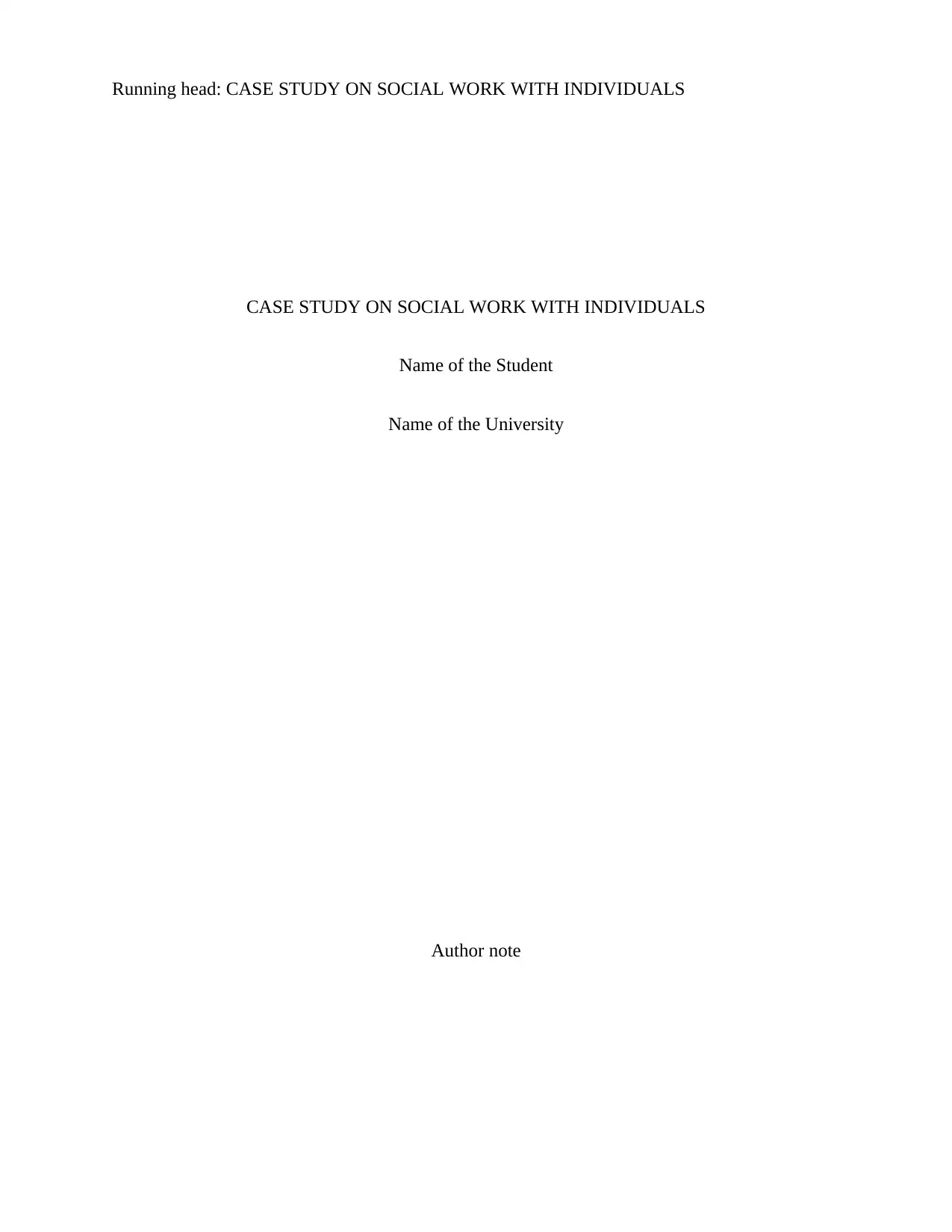
Running head: CASE STUDY ON SOCIAL WORK WITH INDIVIDUALS
CASE STUDY ON SOCIAL WORK WITH INDIVIDUALS
Name of the Student
Name of the University
Author note
CASE STUDY ON SOCIAL WORK WITH INDIVIDUALS
Name of the Student
Name of the University
Author note
Secure Best Marks with AI Grader
Need help grading? Try our AI Grader for instant feedback on your assignments.
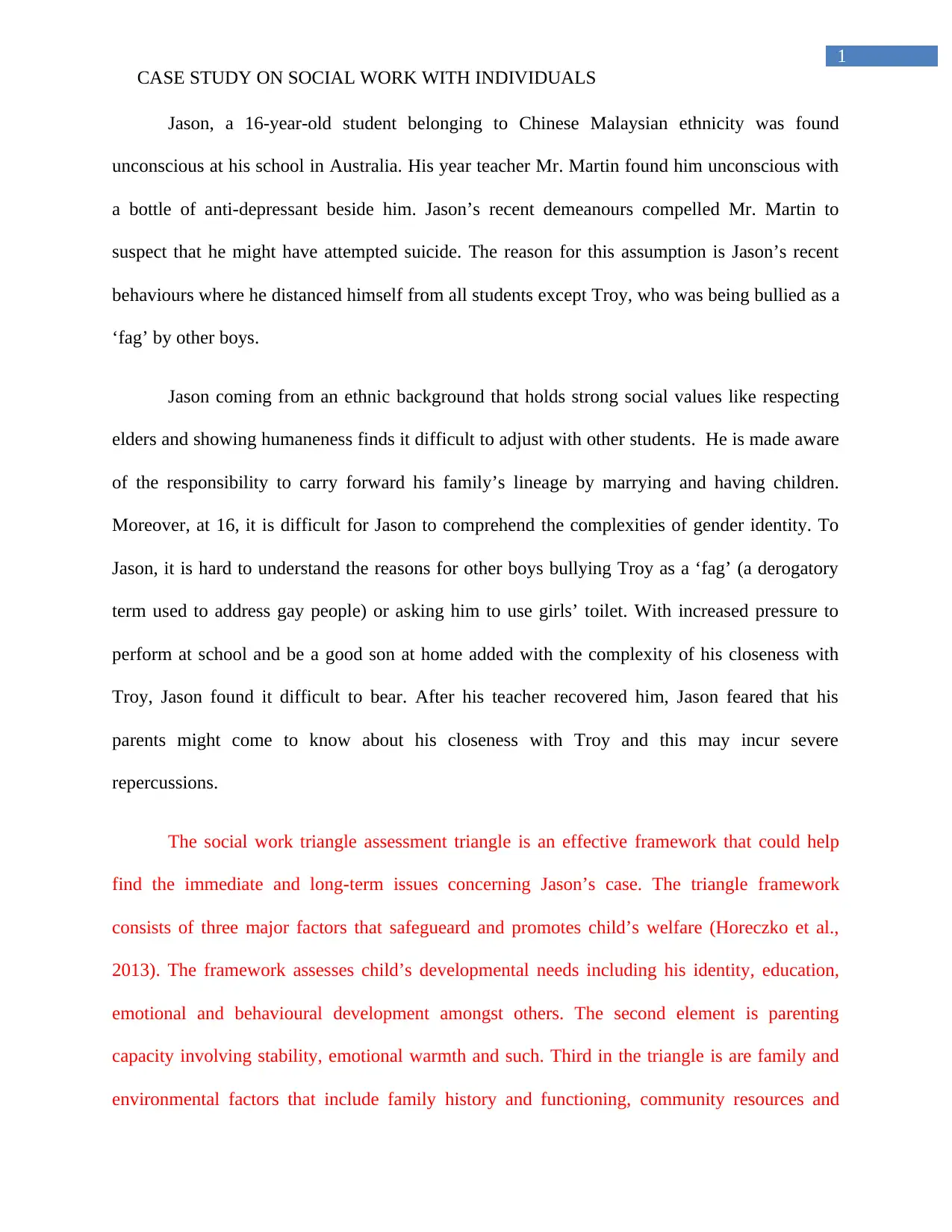
1
CASE STUDY ON SOCIAL WORK WITH INDIVIDUALS
Jason, a 16-year-old student belonging to Chinese Malaysian ethnicity was found
unconscious at his school in Australia. His year teacher Mr. Martin found him unconscious with
a bottle of anti-depressant beside him. Jason’s recent demeanours compelled Mr. Martin to
suspect that he might have attempted suicide. The reason for this assumption is Jason’s recent
behaviours where he distanced himself from all students except Troy, who was being bullied as a
‘fag’ by other boys.
Jason coming from an ethnic background that holds strong social values like respecting
elders and showing humaneness finds it difficult to adjust with other students. He is made aware
of the responsibility to carry forward his family’s lineage by marrying and having children.
Moreover, at 16, it is difficult for Jason to comprehend the complexities of gender identity. To
Jason, it is hard to understand the reasons for other boys bullying Troy as a ‘fag’ (a derogatory
term used to address gay people) or asking him to use girls’ toilet. With increased pressure to
perform at school and be a good son at home added with the complexity of his closeness with
Troy, Jason found it difficult to bear. After his teacher recovered him, Jason feared that his
parents might come to know about his closeness with Troy and this may incur severe
repercussions.
The social work triangle assessment triangle is an effective framework that could help
find the immediate and long-term issues concerning Jason’s case. The triangle framework
consists of three major factors that safegueard and promotes child’s welfare (Horeczko et al.,
2013). The framework assesses child’s developmental needs including his identity, education,
emotional and behavioural development amongst others. The second element is parenting
capacity involving stability, emotional warmth and such. Third in the triangle is are family and
environmental factors that include family history and functioning, community resources and
CASE STUDY ON SOCIAL WORK WITH INDIVIDUALS
Jason, a 16-year-old student belonging to Chinese Malaysian ethnicity was found
unconscious at his school in Australia. His year teacher Mr. Martin found him unconscious with
a bottle of anti-depressant beside him. Jason’s recent demeanours compelled Mr. Martin to
suspect that he might have attempted suicide. The reason for this assumption is Jason’s recent
behaviours where he distanced himself from all students except Troy, who was being bullied as a
‘fag’ by other boys.
Jason coming from an ethnic background that holds strong social values like respecting
elders and showing humaneness finds it difficult to adjust with other students. He is made aware
of the responsibility to carry forward his family’s lineage by marrying and having children.
Moreover, at 16, it is difficult for Jason to comprehend the complexities of gender identity. To
Jason, it is hard to understand the reasons for other boys bullying Troy as a ‘fag’ (a derogatory
term used to address gay people) or asking him to use girls’ toilet. With increased pressure to
perform at school and be a good son at home added with the complexity of his closeness with
Troy, Jason found it difficult to bear. After his teacher recovered him, Jason feared that his
parents might come to know about his closeness with Troy and this may incur severe
repercussions.
The social work triangle assessment triangle is an effective framework that could help
find the immediate and long-term issues concerning Jason’s case. The triangle framework
consists of three major factors that safegueard and promotes child’s welfare (Horeczko et al.,
2013). The framework assesses child’s developmental needs including his identity, education,
emotional and behavioural development amongst others. The second element is parenting
capacity involving stability, emotional warmth and such. Third in the triangle is are family and
environmental factors that include family history and functioning, community resources and
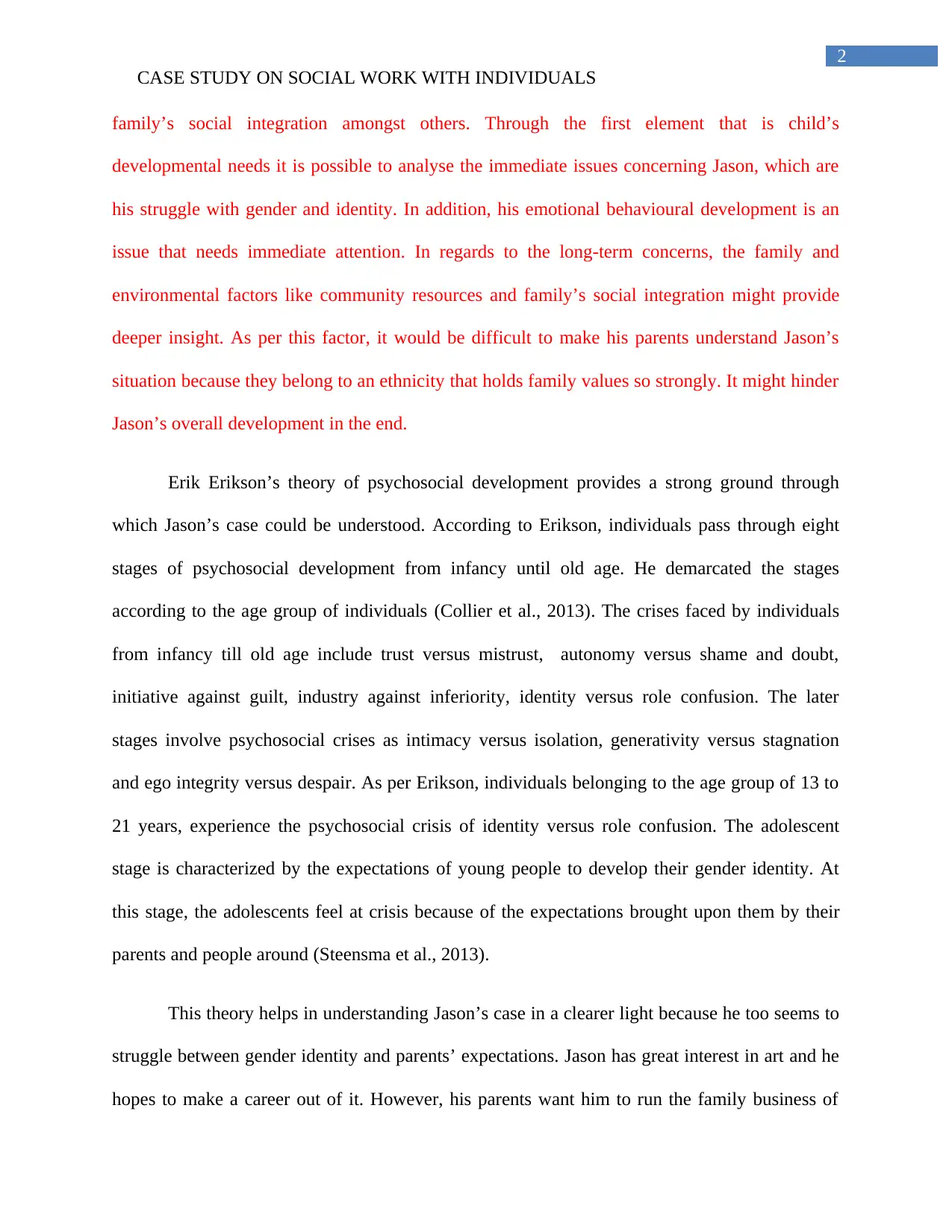
2
CASE STUDY ON SOCIAL WORK WITH INDIVIDUALS
family’s social integration amongst others. Through the first element that is child’s
developmental needs it is possible to analyse the immediate issues concerning Jason, which are
his struggle with gender and identity. In addition, his emotional behavioural development is an
issue that needs immediate attention. In regards to the long-term concerns, the family and
environmental factors like community resources and family’s social integration might provide
deeper insight. As per this factor, it would be difficult to make his parents understand Jason’s
situation because they belong to an ethnicity that holds family values so strongly. It might hinder
Jason’s overall development in the end.
Erik Erikson’s theory of psychosocial development provides a strong ground through
which Jason’s case could be understood. According to Erikson, individuals pass through eight
stages of psychosocial development from infancy until old age. He demarcated the stages
according to the age group of individuals (Collier et al., 2013). The crises faced by individuals
from infancy till old age include trust versus mistrust, autonomy versus shame and doubt,
initiative against guilt, industry against inferiority, identity versus role confusion. The later
stages involve psychosocial crises as intimacy versus isolation, generativity versus stagnation
and ego integrity versus despair. As per Erikson, individuals belonging to the age group of 13 to
21 years, experience the psychosocial crisis of identity versus role confusion. The adolescent
stage is characterized by the expectations of young people to develop their gender identity. At
this stage, the adolescents feel at crisis because of the expectations brought upon them by their
parents and people around (Steensma et al., 2013).
This theory helps in understanding Jason’s case in a clearer light because he too seems to
struggle between gender identity and parents’ expectations. Jason has great interest in art and he
hopes to make a career out of it. However, his parents want him to run the family business of
CASE STUDY ON SOCIAL WORK WITH INDIVIDUALS
family’s social integration amongst others. Through the first element that is child’s
developmental needs it is possible to analyse the immediate issues concerning Jason, which are
his struggle with gender and identity. In addition, his emotional behavioural development is an
issue that needs immediate attention. In regards to the long-term concerns, the family and
environmental factors like community resources and family’s social integration might provide
deeper insight. As per this factor, it would be difficult to make his parents understand Jason’s
situation because they belong to an ethnicity that holds family values so strongly. It might hinder
Jason’s overall development in the end.
Erik Erikson’s theory of psychosocial development provides a strong ground through
which Jason’s case could be understood. According to Erikson, individuals pass through eight
stages of psychosocial development from infancy until old age. He demarcated the stages
according to the age group of individuals (Collier et al., 2013). The crises faced by individuals
from infancy till old age include trust versus mistrust, autonomy versus shame and doubt,
initiative against guilt, industry against inferiority, identity versus role confusion. The later
stages involve psychosocial crises as intimacy versus isolation, generativity versus stagnation
and ego integrity versus despair. As per Erikson, individuals belonging to the age group of 13 to
21 years, experience the psychosocial crisis of identity versus role confusion. The adolescent
stage is characterized by the expectations of young people to develop their gender identity. At
this stage, the adolescents feel at crisis because of the expectations brought upon them by their
parents and people around (Steensma et al., 2013).
This theory helps in understanding Jason’s case in a clearer light because he too seems to
struggle between gender identity and parents’ expectations. Jason has great interest in art and he
hopes to make a career out of it. However, his parents want him to run the family business of
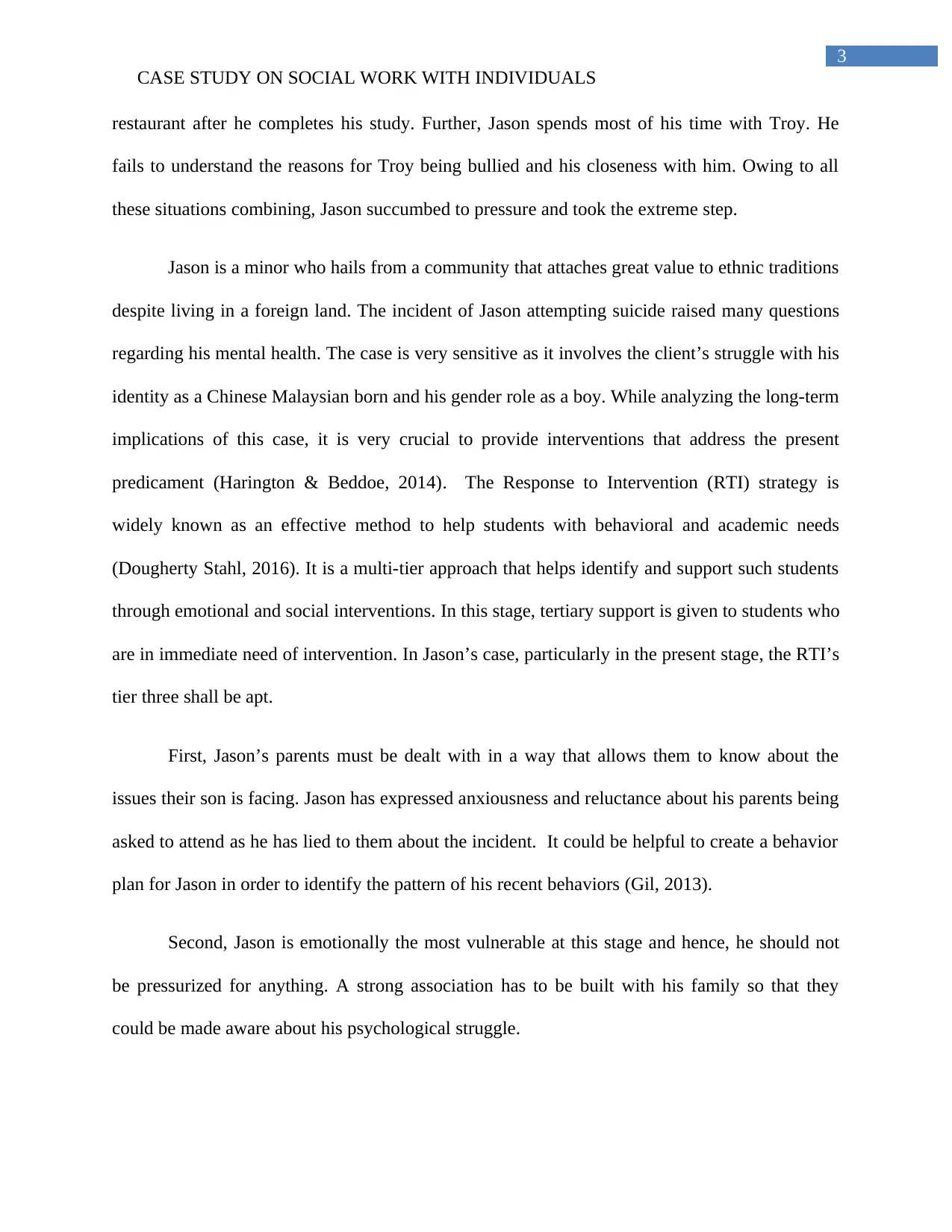
3
CASE STUDY ON SOCIAL WORK WITH INDIVIDUALS
restaurant after he completes his study. Further, Jason spends most of his time with Troy. He
fails to understand the reasons for Troy being bullied and his closeness with him. Owing to all
these situations combining, Jason succumbed to pressure and took the extreme step.
Jason is a minor who hails from a community that attaches great value to ethnic traditions
despite living in a foreign land. The incident of Jason attempting suicide raised many questions
regarding his mental health. The case is very sensitive as it involves the client’s struggle with his
identity as a Chinese Malaysian born and his gender role as a boy. While analyzing the long-term
implications of this case, it is very crucial to provide interventions that address the present
predicament (Harington & Beddoe, 2014). The Response to Intervention (RTI) strategy is
widely known as an effective method to help students with behavioral and academic needs
(Dougherty Stahl, 2016). It is a multi-tier approach that helps identify and support such students
through emotional and social interventions. In this stage, tertiary support is given to students who
are in immediate need of intervention. In Jason’s case, particularly in the present stage, the RTI’s
tier three shall be apt.
First, Jason’s parents must be dealt with in a way that allows them to know about the
issues their son is facing. Jason has expressed anxiousness and reluctance about his parents being
asked to attend as he has lied to them about the incident. It could be helpful to create a behavior
plan for Jason in order to identify the pattern of his recent behaviors (Gil, 2013).
Second, Jason is emotionally the most vulnerable at this stage and hence, he should not
be pressurized for anything. A strong association has to be built with his family so that they
could be made aware about his psychological struggle.
CASE STUDY ON SOCIAL WORK WITH INDIVIDUALS
restaurant after he completes his study. Further, Jason spends most of his time with Troy. He
fails to understand the reasons for Troy being bullied and his closeness with him. Owing to all
these situations combining, Jason succumbed to pressure and took the extreme step.
Jason is a minor who hails from a community that attaches great value to ethnic traditions
despite living in a foreign land. The incident of Jason attempting suicide raised many questions
regarding his mental health. The case is very sensitive as it involves the client’s struggle with his
identity as a Chinese Malaysian born and his gender role as a boy. While analyzing the long-term
implications of this case, it is very crucial to provide interventions that address the present
predicament (Harington & Beddoe, 2014). The Response to Intervention (RTI) strategy is
widely known as an effective method to help students with behavioral and academic needs
(Dougherty Stahl, 2016). It is a multi-tier approach that helps identify and support such students
through emotional and social interventions. In this stage, tertiary support is given to students who
are in immediate need of intervention. In Jason’s case, particularly in the present stage, the RTI’s
tier three shall be apt.
First, Jason’s parents must be dealt with in a way that allows them to know about the
issues their son is facing. Jason has expressed anxiousness and reluctance about his parents being
asked to attend as he has lied to them about the incident. It could be helpful to create a behavior
plan for Jason in order to identify the pattern of his recent behaviors (Gil, 2013).
Second, Jason is emotionally the most vulnerable at this stage and hence, he should not
be pressurized for anything. A strong association has to be built with his family so that they
could be made aware about his psychological struggle.
Secure Best Marks with AI Grader
Need help grading? Try our AI Grader for instant feedback on your assignments.
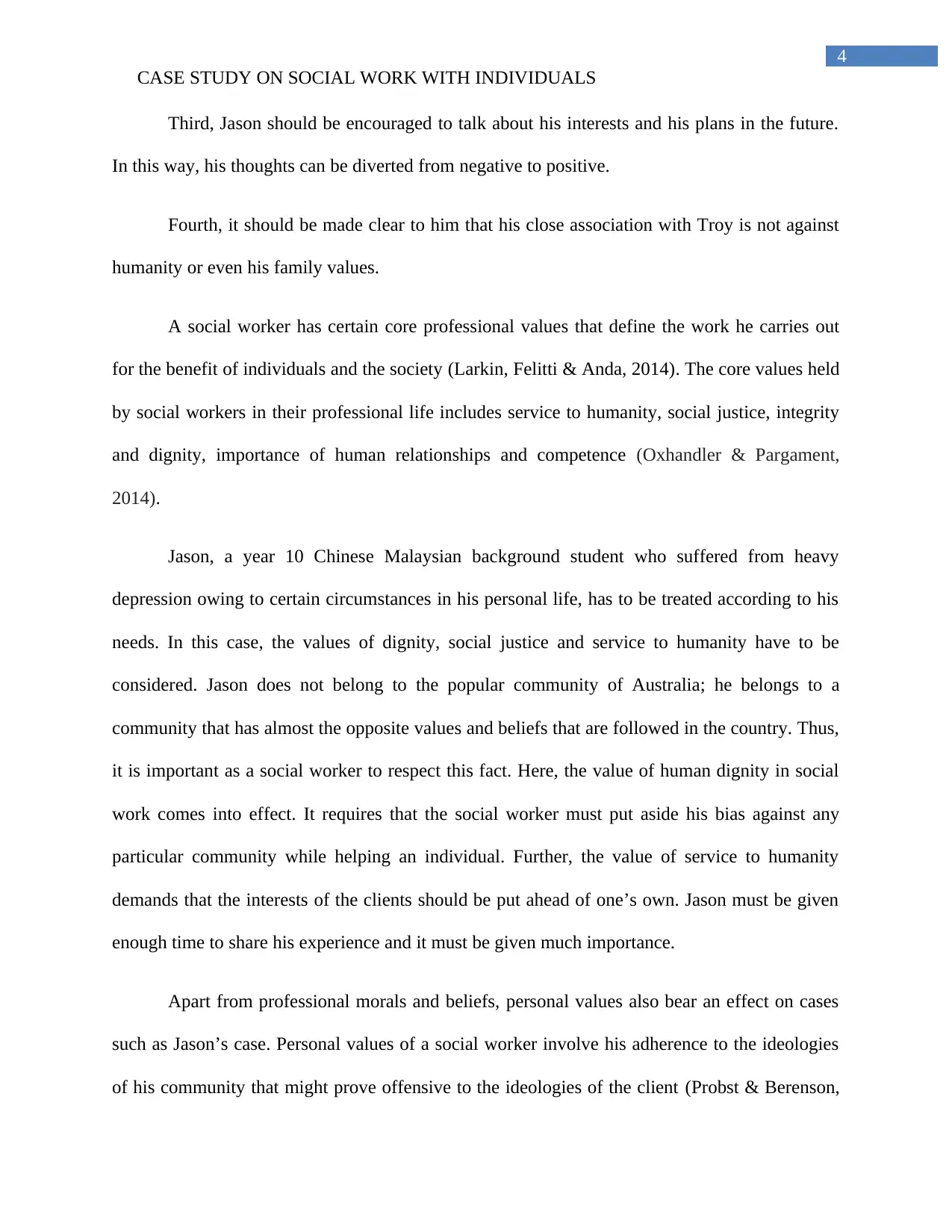
4
CASE STUDY ON SOCIAL WORK WITH INDIVIDUALS
Third, Jason should be encouraged to talk about his interests and his plans in the future.
In this way, his thoughts can be diverted from negative to positive.
Fourth, it should be made clear to him that his close association with Troy is not against
humanity or even his family values.
A social worker has certain core professional values that define the work he carries out
for the benefit of individuals and the society (Larkin, Felitti & Anda, 2014). The core values held
by social workers in their professional life includes service to humanity, social justice, integrity
and dignity, importance of human relationships and competence (Oxhandler & Pargament,
2014).
Jason, a year 10 Chinese Malaysian background student who suffered from heavy
depression owing to certain circumstances in his personal life, has to be treated according to his
needs. In this case, the values of dignity, social justice and service to humanity have to be
considered. Jason does not belong to the popular community of Australia; he belongs to a
community that has almost the opposite values and beliefs that are followed in the country. Thus,
it is important as a social worker to respect this fact. Here, the value of human dignity in social
work comes into effect. It requires that the social worker must put aside his bias against any
particular community while helping an individual. Further, the value of service to humanity
demands that the interests of the clients should be put ahead of one’s own. Jason must be given
enough time to share his experience and it must be given much importance.
Apart from professional morals and beliefs, personal values also bear an effect on cases
such as Jason’s case. Personal values of a social worker involve his adherence to the ideologies
of his community that might prove offensive to the ideologies of the client (Probst & Berenson,
CASE STUDY ON SOCIAL WORK WITH INDIVIDUALS
Third, Jason should be encouraged to talk about his interests and his plans in the future.
In this way, his thoughts can be diverted from negative to positive.
Fourth, it should be made clear to him that his close association with Troy is not against
humanity or even his family values.
A social worker has certain core professional values that define the work he carries out
for the benefit of individuals and the society (Larkin, Felitti & Anda, 2014). The core values held
by social workers in their professional life includes service to humanity, social justice, integrity
and dignity, importance of human relationships and competence (Oxhandler & Pargament,
2014).
Jason, a year 10 Chinese Malaysian background student who suffered from heavy
depression owing to certain circumstances in his personal life, has to be treated according to his
needs. In this case, the values of dignity, social justice and service to humanity have to be
considered. Jason does not belong to the popular community of Australia; he belongs to a
community that has almost the opposite values and beliefs that are followed in the country. Thus,
it is important as a social worker to respect this fact. Here, the value of human dignity in social
work comes into effect. It requires that the social worker must put aside his bias against any
particular community while helping an individual. Further, the value of service to humanity
demands that the interests of the clients should be put ahead of one’s own. Jason must be given
enough time to share his experience and it must be given much importance.
Apart from professional morals and beliefs, personal values also bear an effect on cases
such as Jason’s case. Personal values of a social worker involve his adherence to the ideologies
of his community that might prove offensive to the ideologies of the client (Probst & Berenson,
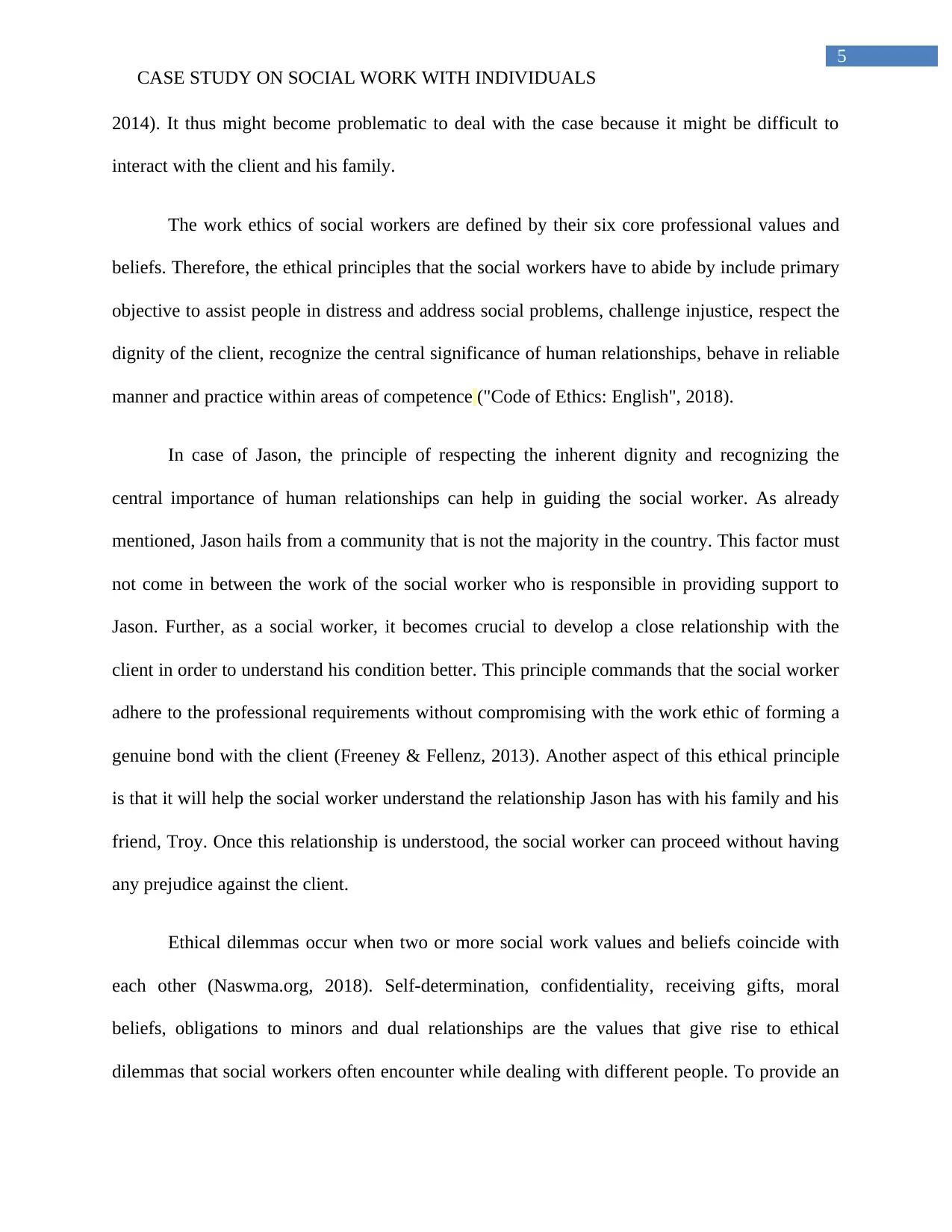
5
CASE STUDY ON SOCIAL WORK WITH INDIVIDUALS
2014). It thus might become problematic to deal with the case because it might be difficult to
interact with the client and his family.
The work ethics of social workers are defined by their six core professional values and
beliefs. Therefore, the ethical principles that the social workers have to abide by include primary
objective to assist people in distress and address social problems, challenge injustice, respect the
dignity of the client, recognize the central significance of human relationships, behave in reliable
manner and practice within areas of competence ("Code of Ethics: English", 2018).
In case of Jason, the principle of respecting the inherent dignity and recognizing the
central importance of human relationships can help in guiding the social worker. As already
mentioned, Jason hails from a community that is not the majority in the country. This factor must
not come in between the work of the social worker who is responsible in providing support to
Jason. Further, as a social worker, it becomes crucial to develop a close relationship with the
client in order to understand his condition better. This principle commands that the social worker
adhere to the professional requirements without compromising with the work ethic of forming a
genuine bond with the client (Freeney & Fellenz, 2013). Another aspect of this ethical principle
is that it will help the social worker understand the relationship Jason has with his family and his
friend, Troy. Once this relationship is understood, the social worker can proceed without having
any prejudice against the client.
Ethical dilemmas occur when two or more social work values and beliefs coincide with
each other (Naswma.org, 2018). Self-determination, confidentiality, receiving gifts, moral
beliefs, obligations to minors and dual relationships are the values that give rise to ethical
dilemmas that social workers often encounter while dealing with different people. To provide an
CASE STUDY ON SOCIAL WORK WITH INDIVIDUALS
2014). It thus might become problematic to deal with the case because it might be difficult to
interact with the client and his family.
The work ethics of social workers are defined by their six core professional values and
beliefs. Therefore, the ethical principles that the social workers have to abide by include primary
objective to assist people in distress and address social problems, challenge injustice, respect the
dignity of the client, recognize the central significance of human relationships, behave in reliable
manner and practice within areas of competence ("Code of Ethics: English", 2018).
In case of Jason, the principle of respecting the inherent dignity and recognizing the
central importance of human relationships can help in guiding the social worker. As already
mentioned, Jason hails from a community that is not the majority in the country. This factor must
not come in between the work of the social worker who is responsible in providing support to
Jason. Further, as a social worker, it becomes crucial to develop a close relationship with the
client in order to understand his condition better. This principle commands that the social worker
adhere to the professional requirements without compromising with the work ethic of forming a
genuine bond with the client (Freeney & Fellenz, 2013). Another aspect of this ethical principle
is that it will help the social worker understand the relationship Jason has with his family and his
friend, Troy. Once this relationship is understood, the social worker can proceed without having
any prejudice against the client.
Ethical dilemmas occur when two or more social work values and beliefs coincide with
each other (Naswma.org, 2018). Self-determination, confidentiality, receiving gifts, moral
beliefs, obligations to minors and dual relationships are the values that give rise to ethical
dilemmas that social workers often encounter while dealing with different people. To provide an
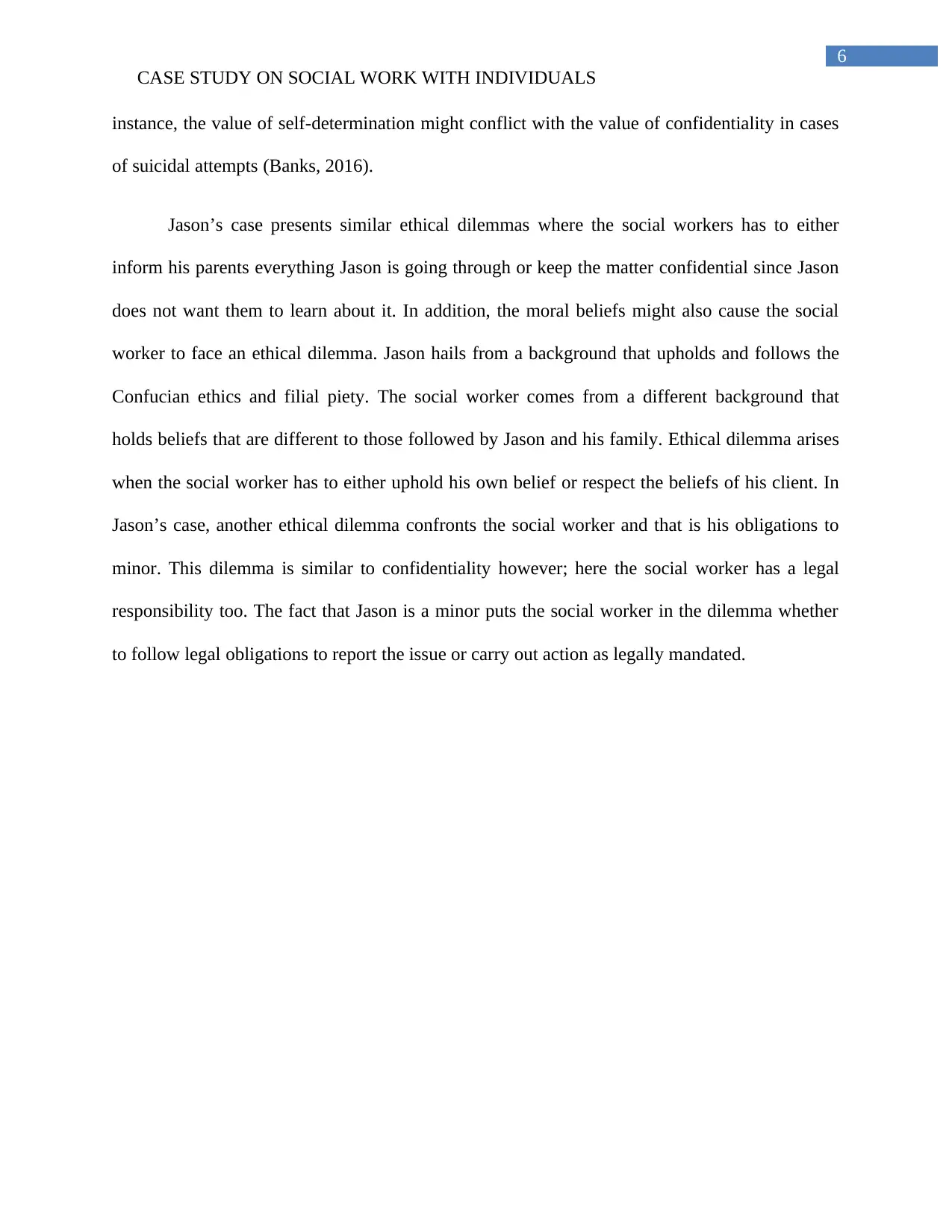
6
CASE STUDY ON SOCIAL WORK WITH INDIVIDUALS
instance, the value of self-determination might conflict with the value of confidentiality in cases
of suicidal attempts (Banks, 2016).
Jason’s case presents similar ethical dilemmas where the social workers has to either
inform his parents everything Jason is going through or keep the matter confidential since Jason
does not want them to learn about it. In addition, the moral beliefs might also cause the social
worker to face an ethical dilemma. Jason hails from a background that upholds and follows the
Confucian ethics and filial piety. The social worker comes from a different background that
holds beliefs that are different to those followed by Jason and his family. Ethical dilemma arises
when the social worker has to either uphold his own belief or respect the beliefs of his client. In
Jason’s case, another ethical dilemma confronts the social worker and that is his obligations to
minor. This dilemma is similar to confidentiality however; here the social worker has a legal
responsibility too. The fact that Jason is a minor puts the social worker in the dilemma whether
to follow legal obligations to report the issue or carry out action as legally mandated.
CASE STUDY ON SOCIAL WORK WITH INDIVIDUALS
instance, the value of self-determination might conflict with the value of confidentiality in cases
of suicidal attempts (Banks, 2016).
Jason’s case presents similar ethical dilemmas where the social workers has to either
inform his parents everything Jason is going through or keep the matter confidential since Jason
does not want them to learn about it. In addition, the moral beliefs might also cause the social
worker to face an ethical dilemma. Jason hails from a background that upholds and follows the
Confucian ethics and filial piety. The social worker comes from a different background that
holds beliefs that are different to those followed by Jason and his family. Ethical dilemma arises
when the social worker has to either uphold his own belief or respect the beliefs of his client. In
Jason’s case, another ethical dilemma confronts the social worker and that is his obligations to
minor. This dilemma is similar to confidentiality however; here the social worker has a legal
responsibility too. The fact that Jason is a minor puts the social worker in the dilemma whether
to follow legal obligations to report the issue or carry out action as legally mandated.
Paraphrase This Document
Need a fresh take? Get an instant paraphrase of this document with our AI Paraphraser
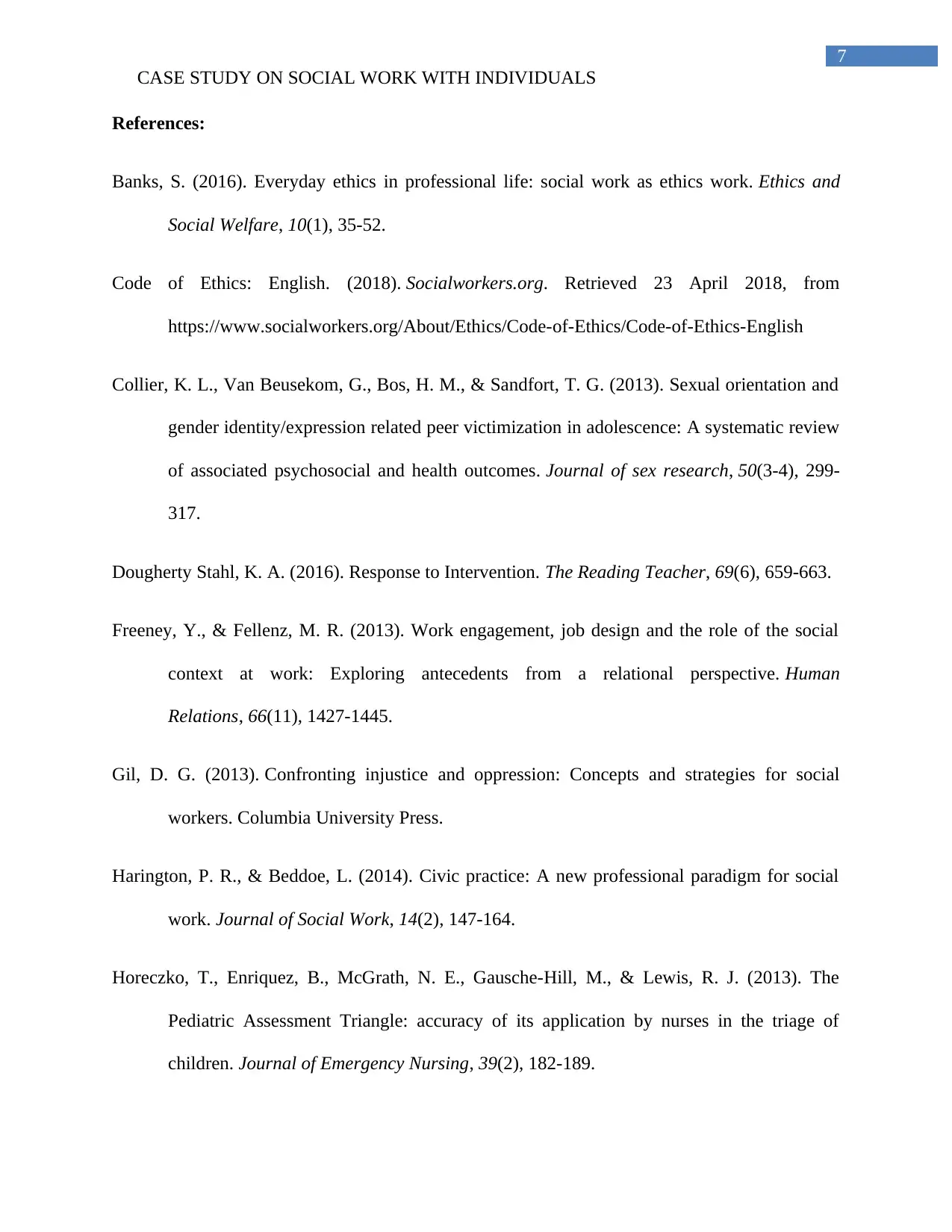
7
CASE STUDY ON SOCIAL WORK WITH INDIVIDUALS
References:
Banks, S. (2016). Everyday ethics in professional life: social work as ethics work. Ethics and
Social Welfare, 10(1), 35-52.
Code of Ethics: English. (2018). Socialworkers.org. Retrieved 23 April 2018, from
https://www.socialworkers.org/About/Ethics/Code-of-Ethics/Code-of-Ethics-English
Collier, K. L., Van Beusekom, G., Bos, H. M., & Sandfort, T. G. (2013). Sexual orientation and
gender identity/expression related peer victimization in adolescence: A systematic review
of associated psychosocial and health outcomes. Journal of sex research, 50(3-4), 299-
317.
Dougherty Stahl, K. A. (2016). Response to Intervention. The Reading Teacher, 69(6), 659-663.
Freeney, Y., & Fellenz, M. R. (2013). Work engagement, job design and the role of the social
context at work: Exploring antecedents from a relational perspective. Human
Relations, 66(11), 1427-1445.
Gil, D. G. (2013). Confronting injustice and oppression: Concepts and strategies for social
workers. Columbia University Press.
Harington, P. R., & Beddoe, L. (2014). Civic practice: A new professional paradigm for social
work. Journal of Social Work, 14(2), 147-164.
Horeczko, T., Enriquez, B., McGrath, N. E., Gausche-Hill, M., & Lewis, R. J. (2013). The
Pediatric Assessment Triangle: accuracy of its application by nurses in the triage of
children. Journal of Emergency Nursing, 39(2), 182-189.
CASE STUDY ON SOCIAL WORK WITH INDIVIDUALS
References:
Banks, S. (2016). Everyday ethics in professional life: social work as ethics work. Ethics and
Social Welfare, 10(1), 35-52.
Code of Ethics: English. (2018). Socialworkers.org. Retrieved 23 April 2018, from
https://www.socialworkers.org/About/Ethics/Code-of-Ethics/Code-of-Ethics-English
Collier, K. L., Van Beusekom, G., Bos, H. M., & Sandfort, T. G. (2013). Sexual orientation and
gender identity/expression related peer victimization in adolescence: A systematic review
of associated psychosocial and health outcomes. Journal of sex research, 50(3-4), 299-
317.
Dougherty Stahl, K. A. (2016). Response to Intervention. The Reading Teacher, 69(6), 659-663.
Freeney, Y., & Fellenz, M. R. (2013). Work engagement, job design and the role of the social
context at work: Exploring antecedents from a relational perspective. Human
Relations, 66(11), 1427-1445.
Gil, D. G. (2013). Confronting injustice and oppression: Concepts and strategies for social
workers. Columbia University Press.
Harington, P. R., & Beddoe, L. (2014). Civic practice: A new professional paradigm for social
work. Journal of Social Work, 14(2), 147-164.
Horeczko, T., Enriquez, B., McGrath, N. E., Gausche-Hill, M., & Lewis, R. J. (2013). The
Pediatric Assessment Triangle: accuracy of its application by nurses in the triage of
children. Journal of Emergency Nursing, 39(2), 182-189.
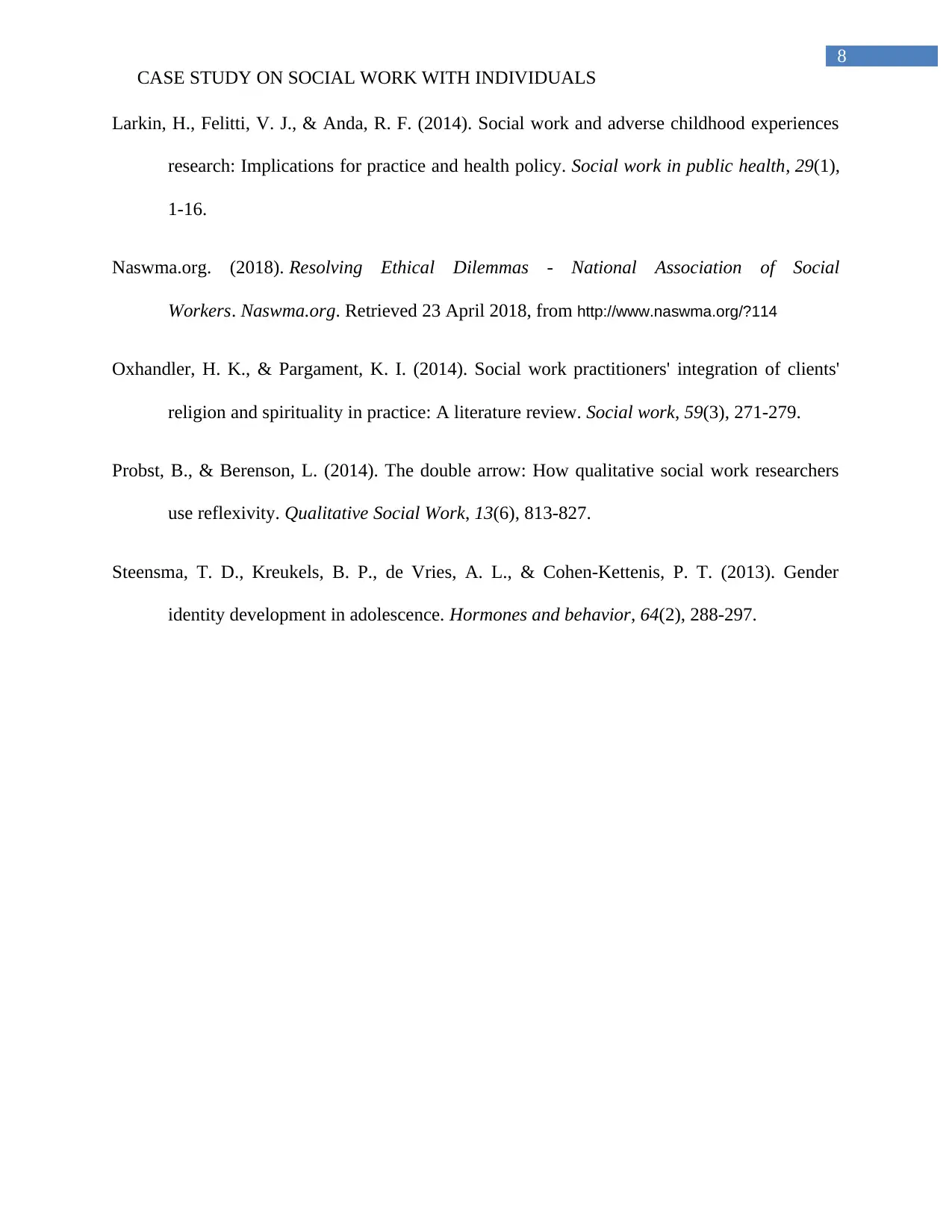
8
CASE STUDY ON SOCIAL WORK WITH INDIVIDUALS
Larkin, H., Felitti, V. J., & Anda, R. F. (2014). Social work and adverse childhood experiences
research: Implications for practice and health policy. Social work in public health, 29(1),
1-16.
Naswma.org. (2018). Resolving Ethical Dilemmas - National Association of Social
Workers. Naswma.org. Retrieved 23 April 2018, from http://www.naswma.org/?114
Oxhandler, H. K., & Pargament, K. I. (2014). Social work practitioners' integration of clients'
religion and spirituality in practice: A literature review. Social work, 59(3), 271-279.
Probst, B., & Berenson, L. (2014). The double arrow: How qualitative social work researchers
use reflexivity. Qualitative Social Work, 13(6), 813-827.
Steensma, T. D., Kreukels, B. P., de Vries, A. L., & Cohen-Kettenis, P. T. (2013). Gender
identity development in adolescence. Hormones and behavior, 64(2), 288-297.
CASE STUDY ON SOCIAL WORK WITH INDIVIDUALS
Larkin, H., Felitti, V. J., & Anda, R. F. (2014). Social work and adverse childhood experiences
research: Implications for practice and health policy. Social work in public health, 29(1),
1-16.
Naswma.org. (2018). Resolving Ethical Dilemmas - National Association of Social
Workers. Naswma.org. Retrieved 23 April 2018, from http://www.naswma.org/?114
Oxhandler, H. K., & Pargament, K. I. (2014). Social work practitioners' integration of clients'
religion and spirituality in practice: A literature review. Social work, 59(3), 271-279.
Probst, B., & Berenson, L. (2014). The double arrow: How qualitative social work researchers
use reflexivity. Qualitative Social Work, 13(6), 813-827.
Steensma, T. D., Kreukels, B. P., de Vries, A. L., & Cohen-Kettenis, P. T. (2013). Gender
identity development in adolescence. Hormones and behavior, 64(2), 288-297.
1 out of 9
Related Documents
Your All-in-One AI-Powered Toolkit for Academic Success.
+13062052269
info@desklib.com
Available 24*7 on WhatsApp / Email
![[object Object]](/_next/static/media/star-bottom.7253800d.svg)
Unlock your academic potential
© 2024 | Zucol Services PVT LTD | All rights reserved.





